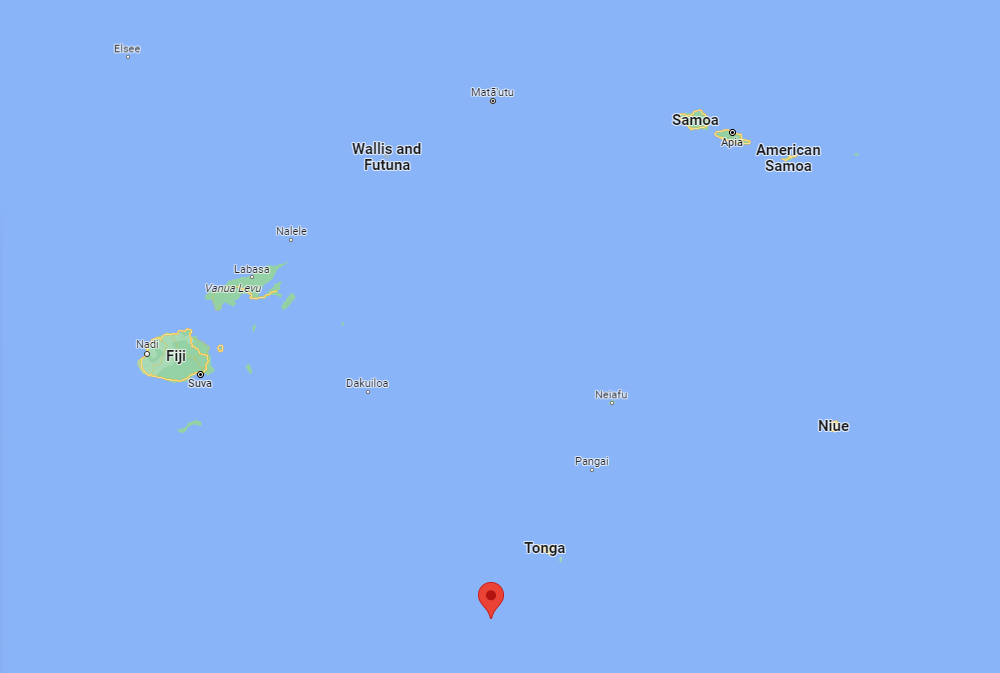If Gilligan’s Island Were Real

Pictured above is a cluster of islands in the South Pacific Ocean. Fiji, the largest of the nations and territories shown, isn’t actually all that large — at about 7,000 square miles (18,000 km2) of land area across its 300+ islands, the archipelago is only a bit bigger than the U.S. state of Delaware. Tonga, toward the bottom of the screenshot, is only about 300 square miles (750 km2). And the flagged area marks the location of ‘Ata — yes, it’s spelled with a leading apostrophe — which is only about half a square mile or 1.5 km2, making it very hard to see on a map. If you really want to see it, here’s a zoomed-in satellite view, but you won’t see much — no one has lived on ‘Ata for more than 150 years.
At least, not intentionally.
In June of 1965, six Tongan boys — all between 15 and 17 years old — decided to skip school. They attended a Catholic boarding school at St. Andrew’s College in Nuku’alofa, Tonga’s capital, on the island of Tongatapu. For reasons unclear, the boys decided that it wasn’t enough to go into town for the day; they really wanted to escape the strict schooling environment. They hastily stole a small boat, measuring only about 24 feet (7.5 meters) long, and set out to sea. They anchored for the night a few miles offshore, probably expecting to return home the next day. But the weather had other ideas. A storm struck their ship, snapping the rope that tied them to the anchor, and for the next eight days, their tiny ship was tossed. The quickly-deteriorating ship crashed down on the shore of that barely-charted, deserted isle — ‘Ata.
Their situation looked bleak. They had no food, their ship was wrecked, and no one knew where they had gone. (Even they probably didn’t know where they were.) And yet, they found a way to stay alive. The only fauna native to ‘Ata are species of rat, which are hard to hunt and don’t provide a lot of meat, so for three months, the boys survived mostly on the meat and eggs of seabirds that landed on the speck of land. Seawater isn’t drinkable (as recently discussed in these pages) so they drank the blood of the very same birds. Survival seemed unlikely — but hope was just around the corner.
A century earlier, ‘Ata was home to a village called Kolomaile. which at its peak had about 350 people living there. As Wikipedia’s editors explain, Peruvian merchants came to the village ostensibly to hire migrant workers to assist in whaling but quickly realized that they could simply enslave the Kolomaile people instead. When the King of Tonga heard of the Peruvian efforts, he evacuated the people remaining on ‘Ata — but left behind all of the tools and, importantly, the chickens they brought to the island. The six marooned kids didn’t know this history, but they had the good sense to explore the island. And when they ultimately decided to summit the volcanic crater from which ‘Ata was formed, they found the ruins of Kolomaile — including crudely made knives and feral chickens.
This new discovery meant the boys — now able to hunt the chickens, cut root vegetables, and slice open coconuts — could survive on ‘Ata indefinitely. And they believed they’d have to. They started planting beans, taming the chickens for breeding, and even setting up a net with makeshift tennis rackets so they could get additional exercise. The next twelve months, their experience was mundane but mostly manageable.
And then, the unimaginable happened: a boat appeared just off the coast of ‘Ata. On September 11, 1966, a fishing ship captained by an Australian named Peter Warner came across the island. The boys were rescued.
Upon returning to Tongo, the six boys were met with fanfare — they had been presumed dead and had already been given funerals. But not everyone was immediately happy with the boys’ return. Warner funded a party to celebrate their return home, but the boys did not turn up — as the Guardian explains, “the boys were imprisoned – the boat they had taken more than a year previously was stolen and the boat’s owner decided to press charges.” Warner, upon discovering this, paid their bail.
A month after the boys were rescued, an Australian TV channel brought them back to ‘Ata for a few days (don’t worry!) to film a documentary on their ordeal. You can — and should! — watch that, here.
Bonus fact: The familiar Gilligan’s Island theme song (watch here) lists recounts the events of the S.S. Minnow and all lists all seven castaways — Gilligan, the skipper (too), the millionaire and his wife, the movie star, the professor, and Mary Ann. But the first season’s theme song (here) was different; instead of referring to “the professor and Mary Ann” specifically, simply referred to them as “and all the rest.” It’s unclear who motivated the change — some sources say that Bob Denver, who played Gilligan, insisted that they be included. (The pilot’s theme song, here, similarly omitted the professor and Mary Ann — and also left out Ginger, the movie star.)
From the Archives: The Yellow Fleet: Not quite castaways, but definitely stuck.
